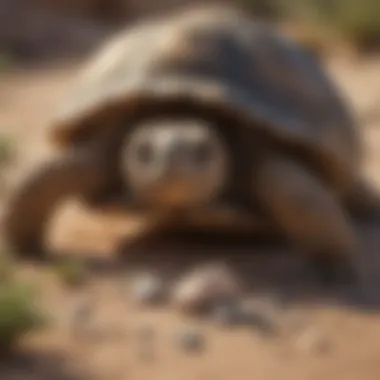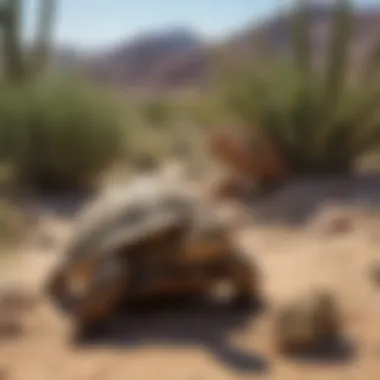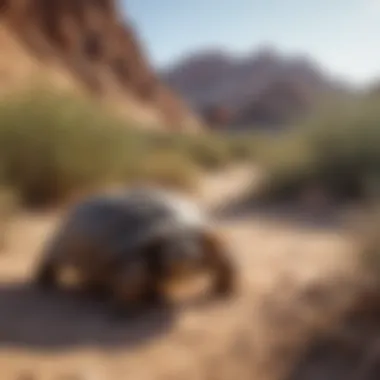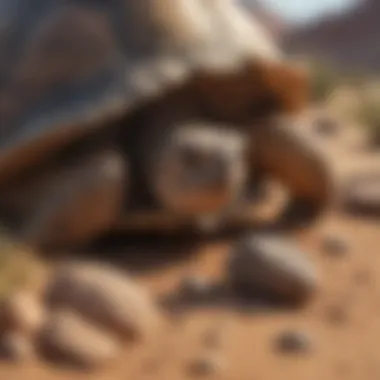Understanding the Dietary Habits of the Desert Tortoise


Nature Topic Overview
The desert tortoise is a remarkable creature that has adapted to one of the planet's harshest environments. In the arid regions of the southwestern United States, these tortoises thrive where temperatures can soar and water is limited. Understanding their dietary habits is crucial for appreciating their role in the ecosystem and the challenges they face due to environmental changes.
Desert tortoises primarily consume a variety of plants, which are carefully chosen based on their nutritional value and availability. Their diet includes grasses, wildflowers, and other vegetation that thrive in desert conditions. By focusing on how these tortoises select their food and how it affects their health, we gain insight into their survival strategies in a landscape that offers little in the way of nourishment.
Fun Facts and Trivia
- Lifespan: Desert tortoises can live for over 50 years, with some reaching ages around 80.
- Size: An adult can weigh between 8 to 30 pounds. Some can even reach a shell length of up to 15 inches!
- Camouflage: Their shells are often camouflaged with patterns that help them blend into the rocky desert landscape.
Understanding these facts about desert tortoises can spark curiosity among children and help them appreciate the resilience of wildlife.
Wildlife Explorations
Desert tortoises are part of a larger desert ecosystem. Other species, like the sidewinder rattlesnake and various lizard types, share their habitat. Here are some interesting facts about their companions:
- Sidewinder Rattlesnake: Known for its unique sideways movement, it is a skillful predator in the sandy deserts.
- Desert Iguanas: These lizards are herbivores too, feeding on plants, and are often seen sharing the same territory as tortoises.
Exploring these organisms can provide lessons in ecology and biological interdependence. Activities such as creating quizzes based on these animals can engage young minds and expand their understanding.
Environmental Awareness
The conservation of desert tortoises is vital due to their vulnerable status. As urbanization expands and climate change affects water supply, their diet is threatened. Initiatives to promote awareness of their habitat’s preservation are essential. Children can participate by:
- Learning about the importance of habitats for tortoises and other wildlife.
- Planting native plants in their gardens that support local wildlife.
- Participating in clean-up initiatives within natural parks.
An appreciation for nature is fostered through these actions, encouraging a sense of responsibility toward the environment.
DIY Nature Activities
Encouraging kids to explore nature, there are various hands-on activities they can undertake related to desert tortoises:
- Create a Desert Habitat Diorama: Use materials like sand, rocks, and plants to model a desert environment.
- Tortoise Shell Art: Craft shell designs using paper plates transformed into tortoise shells, adorned with patterns.
- Nature Scavenger Hunt: Create a list of items found in nature like specific leaves or flowers, as they relate to the tortoise's diet.
These activities not only promote creativity but also deepen their understanding of how desert tortoises survive in their challenging habitat.
Prolusion to Desert Tortoises
The desert tortoise is a remarkable species that plays a significant role in their ecosystem. Understanding their dietary habits is essential for comprehending how they survive and thrive in arid environments. Their unique adaptations and feeding behaviors provide insight into the broader ecological interactions occurring in desert habitats. This section serves as a foundation for understanding the specific needs and preferences of desert tortoises, guiding future discussions regarding their conservation and overall well-being.
Overview of the Species
Desert tortoises, primarily found in the Mojave and Sonoran Deserts of North America, belong to the tortoise family known as Testudinidae. They can live up to 50 years or more in the wild. The shell is dome-shaped and provides protection against environmental hazards. They are well adapted to their surroundings, showcasing significant features that help them conserve moisture and maintain their body temperature. A notable characteristic is their slow metabolism, which aligns with limited food availability in their habitat.


Fact: Desert tortoises can weigh between 8 to 30 pounds and measure 10 to 14 inches in length, depending on age and habitat conditions.
Habitat and Distribution
The natural habitat of the desert tortoise consists of dry, arid regions with sparse vegetation. They prefer open areas but often seek shelter under shrubs or burrow underground to escape the extreme heat. Their distribution spans across various desert landscapes, notably in California, Nevada, Utah, and Arizona. While they thrive in these environments, they are also sensitive to changes in their habitats. Urban development, climate change, and other human activities have resulted in habitat fragmentation, significantly impacting their population.
"The desert tortoise is more than just a creature of its habitat; it is a vital part of the desert ecosystem."
Dietary Preferences of the Desert Tortoise
Understanding the dietary preferences of the desert tortoise is crucial for grasping their overall health, behavior, and adaptation in their natural habitat. Desert tortoises are primarily herbivores, relying heavily on a diet comprised of various plants. This section illustrates how their unique dietary choices are not only essential for their survival but also play a significant role in desert ecosystems.
Herbivorous Nature
The herbivorous nature of desert tortoises defines their eating habits. Unlike carnivores or omnivores, desert tortoises primarily consume plant material. Their digestive systems are specifically adapted to break down fibrous plant material. This diet provides them with necessary nutrients, such as fiber, vitamins, and minerals.
Tortoises do not require animal proteins as part of their diet. Instead, they obtain their energy mainly from the plants they eat. Eating a range of plants helps them meet their nutritional needs and contributes to a balanced diet.
Key Food Sources
Desert tortoises have various key food sources they rely on. Some of the primary plants they consume include:
- Grasses: During warmer months, grasses are plentiful. They consume various species of grasses, which provide hydration and essential nutrients.
- Brittlebush: This plant is favored for its high water content. Brittlebush leaves and stems are a significant part of their diet.
- Prickly Pear Cactus: This succulent serves as a vital food source, especially during summer. The pads and fruits are rich in moisture and sugars, making them appealing to tortoises.
- Wildflowers: Tortoises eat wildflowers in spring. While not a staple, these flowers offer essential vitamins and add variety to their diet.
Each food source plays a role in maintaining the health of the tortoise. When foraging, they often seek these plants depending on what is available in their environment.
Seasonal Variations in Diet
Desert tortoises exhibit seasonal variations in their diet, reflecting the changing availability of food sources throughout the year. In spring, following winter rains, many plants bloom, providing ample food. During this time, tortoises consume more fresh greens and tender shoots.
As summer approaches, certain plants dry up, making food scarce. Tortoises adapt by shifting their diet toward more drought-resistant plants like cacti. In fall, as temperatures cool, they often return to grasses and other plants that are revived by the season’s rains.
"Desert tortoises show remarkable adaptability in their dietary habits, allowing them to thrive in harsh environments."
These seasonal dietary adaptations help them maintain hydration and energy levels. Understanding their dietary preferences reveals how the tortoise is uniquely suited for survival in the desert ecosystem.
Types of Vegetation Consumed
Understanding the types of vegetation consumed by the desert tortoise is essential to comprehending their dietary habits and overall survival. These reptiles are herbivores, which means their diet is primarily composed of plant material. The vegetation they consume provides not only essential nutrients but also hydration, which is crucial in their arid habitats. Each type of plant brings different benefits, and the desert tortoise has evolved to select the most suitable ones throughout the varying seasons.
Grasses and Forbs
Grasses and forbs are integral to the diet of desert tortoises. Grasses offer a high amount of fiber, which aids in digestion. Several species, such as Bermuda grass or Indian wheatgrass, are typical food choices. Forbs, which are flowering plants, add valuable vitamins and minerals. They tend to be more abundant in the spring and early summer, when moisture levels increase due to rainfall. This seasonal availability makes these plants a vital part of the tortoise's diet.


Tortoises often prefer tender young leaves and stems, which provide better nutrients compared to older, tougher parts of the plant.
Succulents and Cacti
Succulents and cacti are special favorites for desert tortoises, particularly during the hotter months. These plants have adapted to store water within their tissues, which makes them an excellent source of hydration for the tortoise. Some common varieties, like the saguaro cactus or the hedgehog cactus, not only provide moisture but also essential nutrients. However, the tortoises must exercise caution. Some cacti have spines that can harm them if not handled properly. When they consume these plants, tortoises often use their strong jaws to munch through the skin and avoid the spines.
Leaves and Flowers
Leaves and flowers provide another crucial element of the desert tortoise’s diet. Tortoises may consume leaves from various shrubs and bushes. These parts of the plants are soft and often more nutritious than stems. Flowers, in particular, are rich in pollen and nectar, making them an attractive food source during blooming seasons. They also provide necessary antioxidants, which can support the tortoise's immune system. The availability of these leafy greens and vibrant flowers can greatly vary with seasons, but when accessible, they enhance the tortoise's nutrition significantly.
Water Retention and Hydration Needs
The desert tortoise has remarkable capabilities to retain water. In arid environments, where water is scarce, these reptiles adapt in unique ways. Understanding the water retention and hydration needs of desert tortoises is vital. It highlights how they survive and thrive despite challenging conditions. Water is not simply a resource; it is critical for their survival, metabolism, and overall health.
Sources of Water in Their Diet
Desert tortoises derive significant hydration from their food. They primarily consume grasses, forbs, and cacti, which have moist content. For instance, the Prickly Pear Cactus and Hedgehog Cactus are particularly important. Tortoises can ingest these plants that contain a high percentage of water. During the rainy season, these food sources become more abundant. Therefore, the tortoises tend to consume even more of them.
- Succulents: These plants store water in their tissues. Their leaves can provide hydration during dry periods.
- Leaves and Flowers: Some of these parts also contain moisture. The tortoise's foraging habits adapt based on availability of these plants.
"Desert tortoises can survive long periods without direct access to water, getting most needed hydration from the vegetation they consume."
Survival Strategies in Arid Environments
Desert tortoises have developed several key strategies to cope with their harsh habitat. First, they are crepuscular, meaning they are most active during early morning and late afternoon. This behavior helps minimize water loss. Another effective strategy is burrowing. During extreme heat, tortoises dig into the ground. This allows them to escape the sun, maintaining body moisture and temperature.
During those moments when water is scarce, they can also slow their metabolism. This helps conserve water, allowing them to survive with little intake. Furthermore, the fat stored in their bodies serves as an energy reserve when food is not available. In summary, the survival strategies of desert tortoises showcase their exceptional adaptations. They symbolize resilience in one of the planet's most challenging environments.
Impact of Human Activity on Diet
Human activity significantly influences the dietary habits of desert tortoises. Understanding how actions such as habitat destruction and pollution affect these creatures is vital for their conservation. The desert tortoise relies on specific food sources within its environment. As these habitats change, it impacts their diet and overall health. Furthermore, changes in vegetation due to human interference can alter the entire desert ecosystem. Addressing these factors is essential for developing effective conservation strategies.
Habitat Destruction
Habitat destruction occurs when the desert regions are disturbed by construction, agricultural expansion, or urban development. These actions can lead to the loss of crucial food sources for desert tortoises. When their habitats become fragmented, the tortoises face challenges in finding adequate nutrition. Activities like road building often kill tortoises directly or cause them to change their behavior for survival. Tortoises may not access their traditional feeding grounds due to obstacles.
Moreover, habitat destruction leads to the decrease of various plant species that are part of their diet. For example, native grasses and wildflowers, which are important food sources, may be replaced by non-native species that do not provide the necessary nutrients.
The following are some key impacts of habitat destruction on desert tortoise dietary habits:
- Loss of Food Sources: With less native vegetation, tortoises struggle to meet their nutritional needs.
- Increased Competition: As habitat ages, more tortoises may compete for limited food, leading to stress and malnutrition.
- Altered Migration Patterns: Tortoises may be forced to travel longer distances to find food, risking injury or predation.
"Protecting the original habitats of desert tortoises ensures their access to the food they need to survive."


Pollution and Contaminants
Pollution poses another threat to the desert tortoise diet. Contaminants can enter their food sources through various means, such as agricultural runoff or industrial waste. When tortoises consume contaminated plants, it can lead to health issues and decreased reproduction. Some pollutants affect their ability to absorb nutrients properly, leading to long-term effects on their growth and survival.
Typical contaminants that affect desert tortoises include:
- Heavy Metals: Chemicals such as lead, which can accumulate in tortoises, are particularly harmful.
- Pesticides: These can poison tortoises if they consume treated plants, affecting their overall well-being.
- Plastic Waste: Ingestion of plastic can lead to gastrointestinal blockage, which is often fatal.
Additionally, pollution can alter plant chemistry. Plants exposed to toxins may have lower nutritional value, impacting tortoise health directly.
Overall, both habitat destruction and pollution play critical roles in shaping the dietary habits of desert tortoises. Conservation efforts need to include strategies to mitigate these human activities. Protecting their habitats and reducing pollution will improve the chances of survival for this unique species.
Research indicates that recovery of desert tortoise populations hinges on understanding these dietary impacts and working towards a healthier ecosystem.
Conservation of Desert Tortoises
Conservation of desert tortoises is crucial for their survival in a rapidly changing environment. These reptiles face numerous threats that endanger their populations. Understanding their diet plays a vital role in conservation efforts. Proper nutrition is essential for their growth, reproduction, and overall health. When their food sources are diminished or polluted, it compromises their ability to thrive. Effective conservation strategies must prioritize their dietary needs alongside habitat protection and restoration.
Importance of Diet in Conservation Efforts
Diet significantly influences the wellbeing of desert tortoises. Knowing what they eat helps in creating effective conservation plans. The nutritional needs of these tortoises are not only about survival, but they also affect their ability to reproduce and maintain a healthy population. If tortoises do not get the right nutrients, it can lead to weak bones, low energy, and other health issues. By ensuring that their natural habitats provide sufficient food, conservationists can promote the growth of healthy tortoise populations.
Some key aspects of diet in conservation include:
- Identifying Key Food Sources: Conservation programs must focus on preserving specific plant species that are critical for tortoises, such as grasses and cacti. These plants provide hydration and essential nutrients.
- Monitoring Nutritional Health: Regular assessments of tortoise health can reveal how diet impacts their populations. This data helps refine conservation measures.
- Promoting Biodiversity: A diverse plant life supports a robust diet for tortoises and enhances ecological resilience. Conservation efforts should aim to maintain ecosystems where multiple plant species thrive.
Protecting Feeding Habitats
Protecting the feeding habitats of desert tortoises is essential to conserve them. These habitats are where they find the plants they need for survival. When humans encroach upon these environments through development or agriculture, tortoises can lose their food sources. Ensuring the integrity of these areas helps support not only the tortoise but also the entire ecosystem.
Methods to protect feeding habitats include:
- Habitat Restoration: Restoration projects can reintroduce native plants that provide food for tortoises. This also helps restore balance in the ecosystem.
- Establishing Protected Areas: Creating reserves can safeguard critical habitats from human activities. This limits disturbances and allows the tortoise populations to recover and thrive.
- Community Involvement: Engaging local communities in conservation efforts creates awareness and promotes the importance of protecting these habitats. Tools like education campaigns can foster a sense of responsibility toward tortoise conservation.
Protecting the feeding habitats of desert tortoises directly impacts their survival and contributes to healthy ecosystems.
Finale
Summary of Key Points
- Dietary Composition: Desert tortoises primarily eat a variety of vegetation, including grasses, forbs, and succulents. These contribute to their hydration needs, which is critical in arid environments.
- Environmental Impact: Their feeding habits influence the desert ecosystem. By consuming certain plants, they help maintain the health of these habitats.
- Challenges of Survival: Habitat destruction and pollution are significant threats. Understanding their dietary needs can help in conservation efforts.
- Importance of Research: Ongoing studies can improve strategies for protecting both the tortoises and their habitat.
Future Research Directions
The future of research on desert tortoises should focus on several key areas:
- Impact of Climate Change: Investigating how changing climates affect the availability of food sources and water is crucial.
- Dietary Adaptations: Further studies could examine how desert tortoises adapt their diet in response to changing environmental conditions.
- Conservation Strategies: New methods must be explored to protect habitats, ensuring that the dietary needs of these tortoises are met.
- Public Awareness and Education: Engaging communities about the significance of maintaining a healthy ecosystem for desert tortoises can foster better support for conservation measures.
In summary, this article has delved into fundamental aspects of the desert tortoise's diet. Future efforts should not only aim to enhance academic knowledge but also promote practical conservation solutions.







